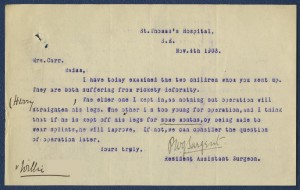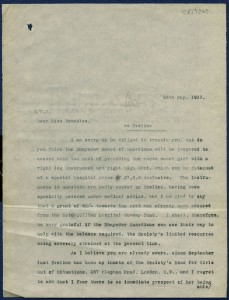Today, we have a guest post written by one of our project volunteers, David Lamb.
***
Earlier this month, the Royal College of Paediatrics and Child Health released guidance for healthcare staff on identifying the symptoms of rickets. This is in response to the rise in rickets, a condition common in Victorian times, but that had largely disappeared through the 20th century. Rickets is a bone-deforming disease caused by vitamin D deficiency, stunting growth and inhibiting walking.
Hospital admissions with rickets in England increased from 561 in 2008/09 to 702 last year. January and February are the worst months because of the low levels of UV light. Observations suggest a link with some children not playing outside. The issue was covered recently in the [London] Evening Standard (13.1.14).
Over 5% of the children who passed through The Children’s Society’s care between 1881 and 1917 had rickets recorded in their case files. Below are extracts from various cases to illustrate the situation in which rickets developed and a range of its impacts.
Three year old Lydia “lives in unhealthy street (in Hackney), and never goes out during the last three months I have known it. She sits with her feet under her, not attempting to walk, and seems to require nourishment and care. The room constantly is so close and smelly it is not conducive to the child’s health, and the mother is too deformed to do her own scrubbing. I think it one of the saddest cases I have ever known”.
The medical certificate for Annie aged six records rickets resulting in bowed legs and curvature of the spine, but “with proper care she is said to be curable”. Almost ten years on, boarded out in Suffolk, she is not considered “capable of carrying heavy weights or doing much hard work. … She takes great pleasure in, and does needlework nicely”.
With six year old Allan from Teesdale, rickets in both legs and wrists had left him “hopelessly crippled unless the deformity is corrected by operation”. The file does not record whether he had that operation. After seven years in Bradstock Lockett Home in Southport, he returned to his mother.
Some children did have their ‘rickety’ condition alleviated by surgery, as in this case below. (Like all the images in this blog, click on the image below to see a larger version.)
Others required special medical or ‘surgical’ appliances, for which funding had to be secured, as in this Welsh case:
Lily from Richmond, Surrey had genu valgum [knock knees] resulting from rickets when younger.
Another rickets case, Sarah, originally from Beverley, Yorkshire was “close upon 15 – but no bigger than a child of 8 – and thus quite debarred from domestic service as she is almost a dwarf”.
With Margaret from Oxfordshire, her rickets developed soon after birth deformities, such that as an eight year old she could not use her legs beyond standing a little. However, she could use her arms well and do needlework. At nearly 16, “she is deformed, height 4ft 3in – not a girl suitable for service – does housework very nicely but her height and limbs are very much against her. She has been through our laundry, but complains of her legs hurting her, after standing or walking far.”
Hopefully, raising the alert about rickets will avoid our generation of children any of the pain, discomfort and disabilities suffered in Victorian and Edwardian times.


